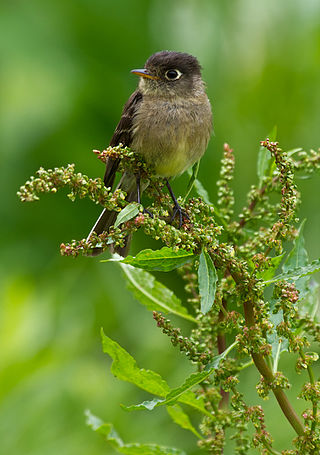
The northern rough-winged swallow is a small, migratory swallow. It is very similar to the southern rough-winged swallow, Stelgidopteryx ruficollis.

The eastern wood pewee is a small tyrant flycatcher from North America. This bird and the western wood pewee were formerly considered a single species. The two species are virtually identical in appearance, and can be distinguished most easily by their calls.

The western wood pewee is a small tyrant flycatcher. Adults are gray-olive on the upperparts with light underparts, washed with olive on the breast. They have two wing bars and a dark bill with yellow at the base of the lower mandible. This bird is very similar in appearance to the eastern wood pewee; the two birds were formerly considered to be one species. The call of C. sordidulus is a loud buzzy peeer; the song consists of three rapid descending tsees ending with a descending peeer.

The olive-sided flycatcher is a small to medium sized passerine bird in the family Tyrannidae, the Tyrant flycatcher family. It is a migratory species that travels from South to North America to breed during the summer. It is a very agile flyer and mainly consumes flying insects on flight. Since 2016, this species has been assessed as being near-threatened globally (IUCN) and threatened in Canada (SRA) due to its declining populations.

The southern tropical pewee is a small passerine bird in the tyrant flycatcher family. It breeds from southern Brazil and Paraguay south to Argentina.

The southern beardless tyrannulet is a small passerine bird in the tyrant flycatcher family. It breeds from Costa Rica through South America south to Paraguay, Bolivia, and Argentina.

The slaty-capped flycatcher is a small passerine bird in the tyrant flycatcher family. It is found in northern Bolivia to Costa Rica and in Trinidad.

The yellow-bellied siskin is a small passerine bird in the finch family Fringillidae. It breeds from Costa Rica south to southern Ecuador, central Bolivia and the highlands of northwestern Venezuela.

The silver-throated tanager is a species of passerine bird in the tanager family Thraupidae. It is found in Costa Rica, Panama, Colombia, Ecuador, and northeastern Peru. It inhabits mossy forests, montane evergreen forests, tropical lowland evergreen forests and forest edges, along with tall secondary forests and disturbed habitat with remnant trees and forest. It is 13 centimetres (5.1 in) long and weighs 22 grams (0.78 oz) on average, and shows slight sexual dimorphism, with duller female plumage. Adult males are mainly bright yellow, with a silvery-white throat bordered above with a black stripe on the cheeks, black streaking on the back, and green edges to the wings and tail. Juveniles are duller and greener.

The golden-bellied flycatcher is a passerine bird in the tyrant flycatcher family. It is an endemic resident breeder in Costa Rica and western Panama.

The black-capped flycatcher is a very small passerine bird in the tyrant flycatcher family. It is endemic to the highlands of Costa Rica and western Panama.

The northern tufted flycatcher or simply tufted flycatcher is a small passerine bird in the tyrant flycatcher family. It breeds in highlands from northwestern Mexico to northwestern Ecuador. The olive flycatcher of Peru and Bolivia is now considered a separate species.

The black-capped pygmy tyrant is the smallest passerine bird in its range, though larger than its cousin, the short-tailed pygmy tyrant. This tyrant flycatcher occurs from Costa Rica to north-western Ecuador.

The slaty flowerpiercer is a passerine bird endemic to the Talamancan montane forests.

The greater pewee is a passerine and is in the tyrant flycatcher group. This species' range is further north than the other Mexican species. This bird was formerly known as Coues' flycatcher.

The northern beardless tyrannulet is a small passerine bird in the tyrant flycatcher family. It breeds from southeasternmost Arizona and Texas of the United States through Mexico and Central America to northwestern Costa Rica.

The Cuban pewee or crescent-eyed pewee is a species of bird in the family Tyrannidae. It is found in Cuba and the northern Bahamas. It was formerly lumped with the Hispaniolan pewee and Jamaican pewee as a single species, the Greater Antillean pewee.

The smoke-colored pewee is a species of bird in the family Tyrannidae. The species is characterized by a uniform dusky-grey plumage.

The Jamaican pewee is a species of bird in the family Tyrannidae. It is endemic to Jamaica. It was formerly regarded as a subspecies of the Greater Antillean pewee.

The gray hawk or Mexican goshawk is a smallish raptor found in open country and forest edges. It is sometimes placed in the genus Asturina as Asturina plagiata. The species was split by the American Ornithological Society (AOU) from the gray-lined hawk. The gray hawk is found from Costa Rica north into the southwestern United States.






















